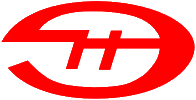
An electric locomotive is a locomotive powered by electricity from overhead lines, a third rail or on-board energy storage such as a battery or a supercapacitor. Locomotives with on-board fuelled prime movers, such as diesel engines or gas turbines, are classed as diesel–electric or gas turbine–electric and not as electric locomotives, because the electric generator/motor combination serves only as a power transmission system.

HS4000 Kestrel was a prototype high-powered mainline diesel locomotive that was built in 1967 by Brush Traction, Loughborough, as a technology demonstrator for potential future British Rail and export orders. The locomotive number is a combination of the initials of Hawker Siddeley and the power rating of its Sulzer diesel engine (4,000 hp), making it the most powerful locomotive built by the company.
Metropolitan-Vickers, Metrovick, or Metrovicks, was a British heavy electrical engineering company of the early-to-mid 20th century formerly known as British Westinghouse. Highly diversified, it was particularly well known for its industrial electrical equipment such as generators, steam turbines, switchgear, transformers, electronics and railway traction equipment. Metrovick holds a place in history as the builders of the first commercial transistor computer, the Metrovick 950, and the first British axial-flow jet engine, the Metropolitan-Vickers F.2. Its factory in Trafford Park, Manchester, was for most of the 20th century one of the biggest and most important heavy engineering facilities in Britain and the world.

Dieselisation is the process of equipping vehicles with a diesel engine or diesel engines.

The Malyshev Factory, formerly the Kharkov Locomotive Factory, is a state-owned manufacturer of heavy equipment in Kharkiv, Ukraine. It was named after the Soviet politician Vyacheslav Malyshev. The factory is part of the state concern, Ukroboronprom.

Elektrichka is a Soviet and Eastern bloc commuter (regional) mostly suburban electrical multiple unit passenger train. Elektrichkas are widespread in Russia, Ukraine and other countries of the former Warsaw Pact presenting a socially vital mode of transportation. In 2007, 4085 commuter trains a day were running on the Russian Railways network alone, most of them electric. The first elektrichka train on July 6, 1926, along the Baku–Sabunchi line in Soviet Azerbaijan. Also urban (intra-city) gorodskaya elektrichkas and airport's aeroexpresses exist in a few cities of Russia, Ukraine, and Belarus.

The M62 is a Soviet-built diesel locomotive for heavy freight trains, exported to many Eastern Bloc countries as well as to Cuba, North Korea and Mongolia. Beside the single locomotive M62 also twin versions 2M62 and three-section versions 3M62 have been built. A total number of 7,164 single sections have been produced, which have been used to build 5,231 single-, twin- and three-section locomotives.
The history of rail transport in Poland dates back to the first half of the 19th century when railways were built under Prussian, Russian, and Austrian rule. Of course, "divided Poland" in the 19th century was the territory of the former Polish–Lithuanian Commonwealth rather than today's Republic of Poland. After Polish independence was declared on 11 November 1918, the independent Polish state administered its own railways until control was surrendered to German and Soviet occupiers during World War II.
Luhanskteplovoz, earlier known as Voroshilovgrad Locomotive Works is a large industrial company in Luhansk, Ukraine, manufacturing locomotives, multiple unit trains as well as other heavy equipment. Due to the war in Donbas it has not been operating since March 2015. According to media reports, by late 2015 the works were looted and completely inoperational.

Krasnoye Sormovo Shipyard No. 112 named after Andrei Zhdanov is one of the oldest shipbuilding factories in Russia, located in the Sormovsky City District of Nizhny Novgorod.

Metrowagonmash, also Metrovagonmash, is an engineering company in Mytishchi, Russia. Metrowagonmash (MWM) is one of the leading enterprises in Russia operating in the field of transport machine building. It specializes in development, designing and manufacturing of rolling stock for metro systems and railways. Metrowagonmash is part of Transmashholding.

Novocherkassk Electric Locomotive Plant, established in 1936, is based in the Russian town of Novocherkassk, Rostov Region. It is now (2015) part of Transmashholding. NEVZ locomotives haul trains transporting 80% of all cargo on the electrified railways of Russia and CIS countries. On its production lines, the plant has produced around 15,000 locomotives of more than 40 types.

The Soviet Union was heavily dependent on rail transport, not least during the Russian Civil War and World War II, but also for industrialization according to the five-year plans.

The Soviet locomotive class FD was a Soviet main freight steam locomotive type named after Felix Dzerzhinsky. Between 1932 and 1942, 3213 FD series locomotives were built.
CRRC Dalian Co., Ltd., often abbreviated as DLoco, is a company located in Dalian, Liaoning Province, China, producing railway locomotives, multiple units and diesel engines.

The Korean State Railway, commonly called the State Rail, is the operating arm of the Ministry of Railways of North Korea and has its headquarters at P'yŏngyang. The current Minister of Railways is Chang Jun-song.

While the former Soviet Union got a late start with rail electrification in 1926 it eventually became the world leader in electrification in terms of the volume of traffic under the wires. During its last 30 years the Soviet Union hauled about as much rail freight as all the other countries in the world combined and in the end, over 60% of this was by electric locomotives. Electrification was cost effective due to the very high density of traffic and was at times projected to yield at least a 10% return on electrification investment. By 1990, the electrification was about half 3 kV DC and half 25 kV AC 50 Hz and 70% of rail passenger-km was by electric railways.

The Kolomna Locomotive Works is a major producer of railway locomotives as well as locomotive and marine diesel engines in Russia. The plant started production in 1869 with a freight steam locomotive, one of the first in Russia. In the Russian Empire, Kolomna was one of the few producers in Russia. During this period, 139 types of steam locomotives were designed. As of 2015, the company is now a part of Transmashholding.

The Soviet locomotive class P36 was a Soviet mainline passenger steam locomotive type. Between 1950 and 1956, 251 locomotives were built. The locomotives were nicknamed "Generals" because of the red stripe down the side. The P36 had the same power as a class IS locomotive but the axle loading of 18 tons allowed its use on the vast majority of Russian railway lines, replacing class Su 2-6-2s and significantly increasing the weight of passenger trains. The P36 was the last type of mainline steam locomotive built in the Russian SFSR and the last one built, P36-0251, was the last steam locomotive produced by Kolomna Works, Russian SFSR. Though sometimes described as the "Victory" type locomotive, that nick-name actually belongs to the class L 2-10-0 built between 1945 and 1947.
The Korean State Railway (Kukch'ŏl) operates a wide variety of electric, diesel and steam locomotives, along with a variety of electric multiple unit passenger trains. Kukch'ŏl's motive power has been obtained from various sources. Much, mostly steam and Japanese-made electric locomotives, was inherited from the Chosen Government Railway, the South Manchuria Railway (Mantetsu) and various privately owned railways of the colonial era. Many steam locomotives were supplied by various communist countries in the 1950s, including the Soviet Union, Czechoslovakia, Hungary, Poland, Romania, and China.














